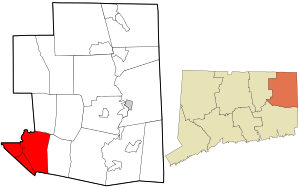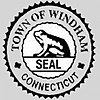Windham, Connecticut
| Windham, Connecticut | ||
|---|---|---|
| Town | ||
|
||
 Location in Windham County and the state of Connecticut. |
||
| Coordinates: 41°43′N 72°10′W / 41.717°N 72.167°WCoordinates: 41°43′N 72°10′W / 41.717°N 72.167°W | ||
| Country | United States | |
| State | Connecticut | |
| NECTA | Willimantic | |
| Region | Windham Region | |
| Incorporated | 1692 | |
| Government | ||
| • Type | Town council | |
| • Mayor | Ernest S. Eldridge | |
| • Council president | N. Joseph Underwood | |
| Area | ||
| • Total | 27.9 sq mi (72.3 km2) | |
| • Land | 27.1 sq mi (70.1 km2) | |
| • Water | 0.9 sq mi (2.2 km2) | |
| Elevation | 233 ft (71 m) | |
| Population (2010) | ||
| • Total | 25,268 | |
| • Density | 876/sq mi (339/km2) | |
| Time zone | Eastern (UTC-5) | |
| • Summer (DST) | Eastern (UTC-4) | |
| ZIP code | 06226, 06235, 06256, 06266, 06280 | |
| Area code(s) | 860 | |
| FIPS code | 09-86790 | |
| GNIS feature ID | 0213537 | |
| Website | www |
|
Windham is a town in Windham County, Connecticut, United States. It contains the borough of Willimantic as well as the villages of Windham Center, North Windham, and South Windham. Willimantic, an incorporated city since 1893, was consolidated with the town in 1983. The population was 25,268 at the 2010 census.
The town of Windham was incorporated on May 12, 1692. Mohican Sachem Chief Joshua willed the land to sixteen men, most of whom resided in Norwich. The land called Windham consisted of what is now the towns of Windham (which includes Willimantic), Mansfield, Scotland, Chaplin, and Hampton.
The town was named after Wyndham, England. On December 4, 1700, Windham’s first Minister, Reverend Samuel Whiting, was ordained. The church was a Congregational Church, stemming from the Puritans. The first church building was erected shortly after on the Windham Green. Early settlers were farmers who grew crops such as wheat, rye, corn, barley, flax, and hemp, as-well-as raising livestock. Early industry in Windham consisted of sawmills, gristmills, and blacksmith’s shops taking advantage of the water power from streams and rivers. In 1823 Windham, along with Lebanon, Columbia, Chaplin, and Mansfield petitioned the General Assembly to become their own county. Tolland County, the last county formed in Connecticut, had just been formed a few years earlier, taking towns away from Hartford and Windham counties. The town of Windham was no longer the center of Windham County. The courts and other government offices had been moved to Brooklyn which was more centralized and easier to travel to. All transportation was difficult due to the poor quality of the roads. The General Assembly denied the petition. One year later, Lebanon petitioned the General Assembly to be returned to New London County, which they had originally been part of before the creation of Windham County. The General Assembly granted their petition. That same year, Mansfield and Columbia petitioned the General Assembly to join Tolland County. The General Assembly denied both petitions. Mansfield tried again in 1826, and Columbia tried again in 1827. This time the General Assembly granted both towns their petitions.
The town of Windham is made up of four parts: North Windham, Windham Center, South Windham, and Willimantic. As with many towns with abundant river water-power, mills are a very large part of the history of the town. The mills sprang up around the Willimantic River in the borough of Willimantic, while Windham remained a farming community. North and South Windham had limited industry. The populated area of the town in the colonial period was Windham Center. When the industrial revolution came to the United States, the mills grew and Willimantic became the more populated area. In 1877 The Willimantic Enterprise newspaper started serving the citizens of Windham and surrounding towns. The newspaper grew, and became the Willimantic Chronicle, and later The Chronicle. The newspaper has been published by the same family for five generations. In 1889 the Willimantic State Normal School opened its doors. (A “normal school” was a school of higher education which women went to after High School to become teachers.) The course of study was two years long. Women signed a contract stating they would only teach in Connecticut and received free tuition and books. Room and board was $3.50 a week. The school became Willimantic State College in 1959, and in 1967 Eastern Connecticut State College. Then in 1983 the college received university status and afterwards became part of the state university system as Eastern Connecticut State University.
...
Wikipedia

